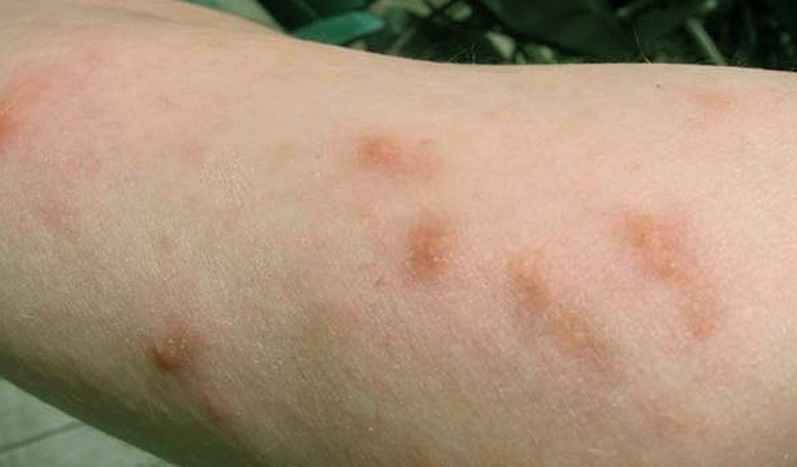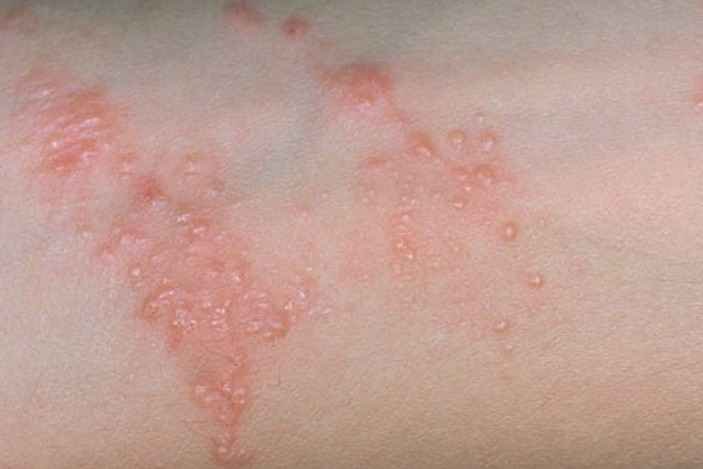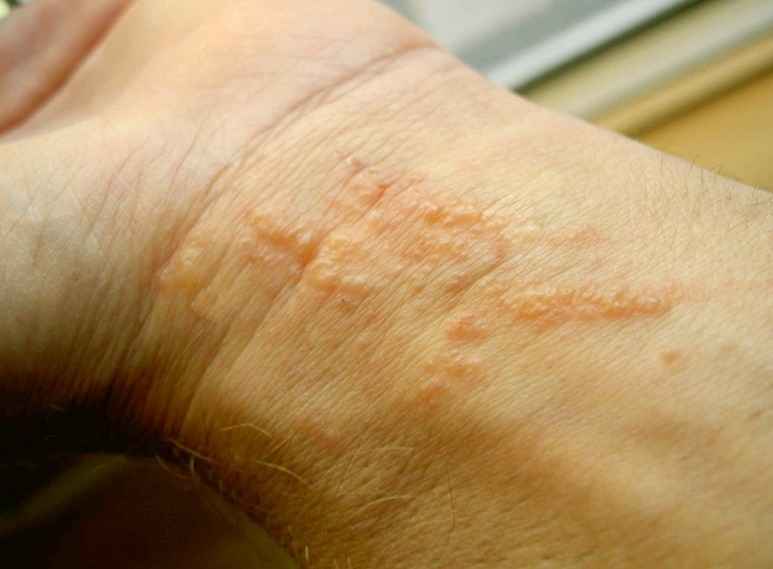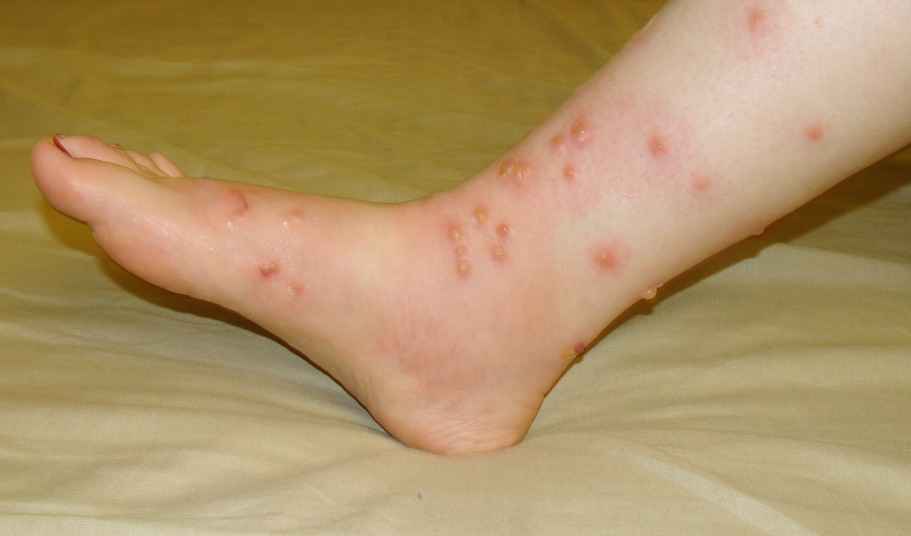What is Poison Ivy?
 Picture of Poison ivy plant[/caption]
Picture of Poison ivy plant[/caption]
Poison ivy is a wild plant found native in America which has also been introduced to Asia, Europe, Australia and New Zealand. There are two types of poison ivy plant as Western poison ivy (Toxicodendron rydbergii) and Eastern poison ivy (Toxicodendron radicans). Western poison ivy which grows as a shrub is the commonest type while Eastern poison ivy grows as vine trailing on the ground or on trees. Both types have shiny and smooth leaves arranged in clusters of three.
What is Poison ivy Rash?
The leaves, flowers, stems and roots of this plant have an oily sap which contains an allergenic component known as Urushiol. Either a direct contact to this chemical compound by brushing against a damaged plant part or an indirect contact via urushiol oil contaminated clothing, tools, footwear, pets or inhalation of smoke of burning poison ivy plant can cause an allergic reaction. The chemical causes allergy at the site of contact, thus resulting in contact dermatitis that leads to a skin rash.
 Picture of Poison ivy rash[/caption]
Picture of Poison ivy rash[/caption]
Symptoms
The sap containing urushiol sticks to the skin very soon and causes the allergy. The symptoms may range from mild to severe. The classic symptoms of contact dermatitis due to poison ivy are:
- Severe itchiness
- Redness
- Swelling
- Small and large papules and vesicles
- Bullae (in severe cases).
Usually the symptoms appear within 24 to 72 hours after the initial contact with the allergen urushiol. Often it peaks within a week and disappears in one to three weeks. Usually the contact dermatitis affects the face, neck, legs and genitalia. The appearance of the rash may vary according to the area of the contact. If the affected area is small, the rash may appear as multiple streaks and patches and if it is a larger area it can be more severe. If a person continues to touch other parts of the body with his/her urushiol contaminated hands, the rash can spread to other parts. Anaphylactic reaction can appear very rarely due to extreme allergy.
Airborne contact by inhaling the fume containing urushiol from a burning plant can irritate the lungs, respiratory tract and eyes. Occasionally lung symptoms can be severe.
Causes
The allergic rash due to poison ivy is because of type-4 hypersensitivity, which is also known as delayed hypersensitivity as it takes 24 to 72 hours to show a response. It is a cell mediated response involving antigen presenting cells including B lymphocytes, macrophages and Langerhan cells and Helper T cells (CD4+ cells). This reaction takes place in two phases, as sensitization and effector phase respectively. During the sensitization phase when an antigen enters the body, antigen presenting cell engulfs it and presents the antigen to T helper cells via its surface molecule MHC class II. When the T helper cell binds with the antigen presented by the antigen presenting cell, the antigen presenting cell secretes IL-12 which activates the T cell and sensitizes it.
During the effector phase the sensitized T helper cell secretes IL-2 which promotes proliferation of other surrounding T cells and THF β and IFN ϒ which activate macrophages. The activated macrophages secrete pro inflammatory cytokines including TNF, IL-1, IL-2, IL-6 which makes the endothelial barriers leaky which results in increased inflow of immune cells to the area which results in redness, edema and warmth. They also secrete lysosomal enzymes, complement components and reactive oxygen species in to the area, thereby causing more damage to the tissues and resulting in the rash.
In the case of poison ivy rash, when the urushiol molecules (antigens) penetrate the epidermis and enter the dermis of the skin, they are picked by Langerhan cells (which is the antigen presenting cell in the skin). These Langerhan cells present the antigen to the T helper cells via MHC class II molecule which is present on its surface and produce IL-12 to sensitize and activate the T helper cells. The activated T helper cells activate macrophages which in turn release more pro inflammatory products which cause inflammation at the site and result in contact dermatitis (poison ivy rash).
Treatment
First of all, upon skin contamination with poison ivy, the contaminated cloth or footwear should be removed and the exposed skin should be cleaned thoroughly with lukewarm water for about fifteen to twenty minutes. Soap or detergent can be used as degreasing agents. Rubbing sanitizers containing alcohol can be used to clean the skin if water is not available. As the urushiol oil gets easily absorbed into the skin, washing the skin as soon as the contamination occurs is important to reduce the effect of the allergen and to reduce the severity of the dermatitis. In addition any clothes or footwear or tools or pets which are contaminated by the plant sap which contains urushiol should be cleaned properly before using them again as the urushiol can remain active on the surfaces for a long period of time and can cause allergy when it is being used for the next time. Eyes should be washed thoroughly using room temperature water or 0.9% normal saline for about fifteen minutes in case of exposure to the eyes.
Usually the dermatitis is self resolving. Within two or three weeks the rash will improve on its own without any complications. So self care will be adequate most of the time. Keeping the affected part of the skin clean, dry and cool are the basic principles of self care. Scratching should be avoided even though the rash is itchy as it may lead to secondary complications. The treatment method depends on the severity and extent of involvement of the rash. Topical measures will suffice for mild to moderate severity and systemic measures are needed if the severity is more.
Some of the common home remedies are as follows:
- A cool compressor using water or diluted aluminum acetate solution can be applied to the skin to cool it.
- A topical steroid can be used for the itching. If the itching doesn’t respond to that, oral anti-histamines such as diphenhydramine can be used. Topical anti-histamines and anesthetics should be avoided.
- Calamine lotion can be used to soothe the affected skin because of its cooling property and it promotes drying of the lesions because of its drying effect.
- Frequent baths using water with colloidal oatmeal or baking soda can be used for its cooling property.
But medical advice should be sought in following instances when:
- The rash doesn’t improve with any home remedies
- The rash keeps on spreading to other body parts
- The rash involving the genitals or the face
- The rash with symptoms of infections
- The area of rash starting to swell
- If the rash covers a large area of the skin
- Continuation of irritation of eyes with pain, lacrimation, swelling even after washing for fifteen minutes.
- Any signs of respiratory tract irritation (difficulty in breathing, continuous cough etc.)
A doctor will take a detailed history and carry on a skin examination to come to a diagnosis. Usually, no blood investigations or imaging will be needed for the diagnosis.
A doctor may prescribe a short course of steroids if the itchiness and rash didn’t respond to anti-histamines. Antibiotics might be prescribed to prevent the complications such as secondary bacterial infections, erythema multiforme and urticaria.
Emergency medical care should be taken in case of an anaphylactic reaction which includes breathing difficulty, swallowing difficulty and facial edema (swelling of lips and around the eyes).
Learning to recognize the plant and avoiding them, and using protective clothing (long sleeved shirts, trousers, gloves) and appropriate footwear, applying ivy blocking creams to skin are some of the preventive measures.
Poison Ivy Rash Pictures
Take a look at these pictures of poison ivy rash to find out how it looks like...





Is Poison ivy rash Contagious?
Although 85% of the population is sensitive to poison ivy, the rash is not contagious from a person to another person. But it can spread from one body part to another as long as the contamination of urushiol remains on the skin.